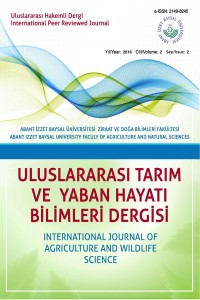Öz
In this study, 4 different cotton (Gossypium hirsutum L.) varieties (Carisma, Flash, PG2018 and Lydia) and a total of 7 doses including 6 NaCl concentrations and a control (0, 25 mM, 50 mM, 75 mM, 100 mM, 125 mM, 150 mM) group were used. Effects of different NaCl concentrations on germination of cotton varieties was examined. The study was arranged in a randomized complete plot in a factorial experiment design with 4 replications. As a result, it was obtained that the average germination rates between varieties were 44.29% (PG2018 and Flash), 35% (Carisma) and 28.57% (Lydia), respectively. In addition, 100 mM NaCl concentration decreased germination rate up to 30%, subsequent doses stopped germination almost completely for whole varieties. It was determined that PG2018 and Flash varieties were more resistant to increasing salt concentrations and different varieties showed significant variability of the response to the concentrations of salt.
Anahtar Kelimeler
Kaynakça
- Amjad J., Yasin M., Nabi G and Rauf A., 2002. Evaluation of germination and growth of cotton by presowing treatments under salt-stressed conditions. Pakistan Journal of Agricultural Research, 17(2): 170-175.
- Çulha Ş ve Çakırlar H., 2011. Tuzluluğun bitkiler üzerine etkileri ve tuz tolerans mekanizmaları. AKÜ Fen ve Mühendislik Bilimleri Dergisi, 11(2): 11-34.
- FAO 2013. http://www.faostat.fao.org. [Erişim: 30 Nisan 2016].
- İzci B., 2009. Pamukta (G. hirsutum L.) farklı tuz konsantrasyonlarının in vitro koşullarda fotosentetik pigmentler üzerine etkisi. Alınteri Zirai Bilimler Dergisi, 17(2): 7-13.
- Kent LM and Lauchli A., 1985. Germination and seedling growth of cotton; salinity-calcium interactions. Plant, Cell and Environment, 8, 155-159.
- McMichael BL., Oosterhuis DM. and Zak JC., 2011. Stress Response in Cotton Root Systems, Seventh Edition, Tennessee, USA. 175 p.
- Munns R., 2002. Comparative physiology of salt and water stress. Plant. Cell and Environment, 25(2): 239-250.
- Öz M ve Karasu A., 2007. Pamuğun çimlenmesi ve erken fide gelişimi üzerine tuz stresinin etkisi. Uludağ Üniversitesi Ziraat Fakültesi Dergisi, 21(1): 9-21.
- Qadir M and Shams M., 1997. Some agronomic and physiological aspects of salt tolerance in cotton (Gossypium hirsutum L.). Journal of Agronomy and Crop Science, 179: 101-106.
- Saleh B., 2012. Salt stress alters physiological indicators in cotton (Gossypium hirsutum L.). Soil & Environment, 31(2): 113-118.
- Tort N., 1996. Effects of light, different growth media, temperature and salt concentrations on germination of cotton seeds (Gossypium hirsutum L. cv. Nazilli 87). Journal of Agronomy and Crop Science, 176: 217-221.
- TÜİK 2015. http://www.tuik.gov.tr. [Erişim: 30 Nisan 2016].
- Yılmaz E., Tuna AL ve Bürün B., 2011. Bitkilerin tuz stresi etkilerine karşı geliştirdikleri tolerans stratejileri. Celal Bayar Üniversitesi Fen Bilimleri Dergisi, 7(1): 47-66.
Öz
Bu çalışmada 4 farklı pamuk (Gossypium hirsutum L.) çeşidi (Carisma, Flash, PG2018 ve Lydia) ve 6 NaCl konsantrasyonu (0 (kontrol), 25, 50, 75, 100, 125 ve 150 mM) ve kontrol grubu olmak üzere toplam 7 doz kullanılmıştır. Araştırmada farklı NaCl konsantrasyonlarının pamukta çimlenme üzerine olan etkisi incelenmiştir. Çalışma tesadüf parsellerinde faktöriyel düzenleme deneme desenine göre 4 tekerrürlü yürütülmüştür. Çalışma sonucunda çeşitler arasında ortalama çimlenme oranları sırasıyla % 44.29 (PG2018 ve Flash), % 35 (Carisma) ve % 28.57 (Lydia) olarak belirlenmiştir. Ayrıca, bütün çeşitlerde 100 mM NaCl konsantrasyonunda çimlenme oranı % 30’a kadar düşmüş, daha yüksek dozlar ise çimlenmeyi neredeyse tamamen durdurmuştur. PG2018 ve Flash çeşitlerinin artan tuz konsantrasyonlarına daha dayanıklı olduğu ve farklı çeşitlerin tuz konsantrasyonlarına tepkilerinin önemli derecede değişkenlik gösterdiği belirlenmiştir.
Kaynakça
- Amjad J., Yasin M., Nabi G and Rauf A., 2002. Evaluation of germination and growth of cotton by presowing treatments under salt-stressed conditions. Pakistan Journal of Agricultural Research, 17(2): 170-175.
- Çulha Ş ve Çakırlar H., 2011. Tuzluluğun bitkiler üzerine etkileri ve tuz tolerans mekanizmaları. AKÜ Fen ve Mühendislik Bilimleri Dergisi, 11(2): 11-34.
- FAO 2013. http://www.faostat.fao.org. [Erişim: 30 Nisan 2016].
- İzci B., 2009. Pamukta (G. hirsutum L.) farklı tuz konsantrasyonlarının in vitro koşullarda fotosentetik pigmentler üzerine etkisi. Alınteri Zirai Bilimler Dergisi, 17(2): 7-13.
- Kent LM and Lauchli A., 1985. Germination and seedling growth of cotton; salinity-calcium interactions. Plant, Cell and Environment, 8, 155-159.
- McMichael BL., Oosterhuis DM. and Zak JC., 2011. Stress Response in Cotton Root Systems, Seventh Edition, Tennessee, USA. 175 p.
- Munns R., 2002. Comparative physiology of salt and water stress. Plant. Cell and Environment, 25(2): 239-250.
- Öz M ve Karasu A., 2007. Pamuğun çimlenmesi ve erken fide gelişimi üzerine tuz stresinin etkisi. Uludağ Üniversitesi Ziraat Fakültesi Dergisi, 21(1): 9-21.
- Qadir M and Shams M., 1997. Some agronomic and physiological aspects of salt tolerance in cotton (Gossypium hirsutum L.). Journal of Agronomy and Crop Science, 179: 101-106.
- Saleh B., 2012. Salt stress alters physiological indicators in cotton (Gossypium hirsutum L.). Soil & Environment, 31(2): 113-118.
- Tort N., 1996. Effects of light, different growth media, temperature and salt concentrations on germination of cotton seeds (Gossypium hirsutum L. cv. Nazilli 87). Journal of Agronomy and Crop Science, 176: 217-221.
- TÜİK 2015. http://www.tuik.gov.tr. [Erişim: 30 Nisan 2016].
- Yılmaz E., Tuna AL ve Bürün B., 2011. Bitkilerin tuz stresi etkilerine karşı geliştirdikleri tolerans stratejileri. Celal Bayar Üniversitesi Fen Bilimleri Dergisi, 7(1): 47-66.
Ayrıntılar
| Bölüm | Tarla Bitkileri |
|---|---|
| Yazarlar | |
| Yayımlanma Tarihi | 8 Aralık 2016 |
| Gönderilme Tarihi | 28 Haziran 2016 |
| Yayımlandığı Sayı | Yıl 2016 Cilt: 2 Sayı: 2 |
![]() Uluslararası Tarım ve Yaban Hayatı Bilimleri Dergisi Creative Commons Attribution 4.0 Generic License a
Uluslararası Tarım ve Yaban Hayatı Bilimleri Dergisi Creative Commons Attribution 4.0 Generic License a

